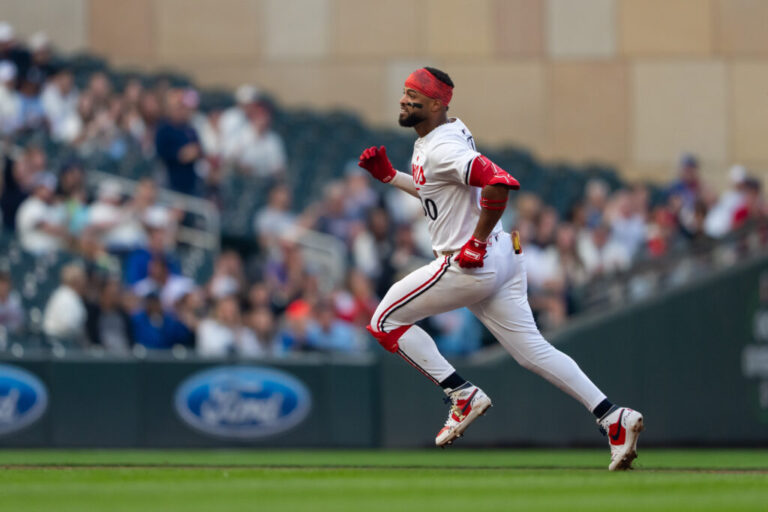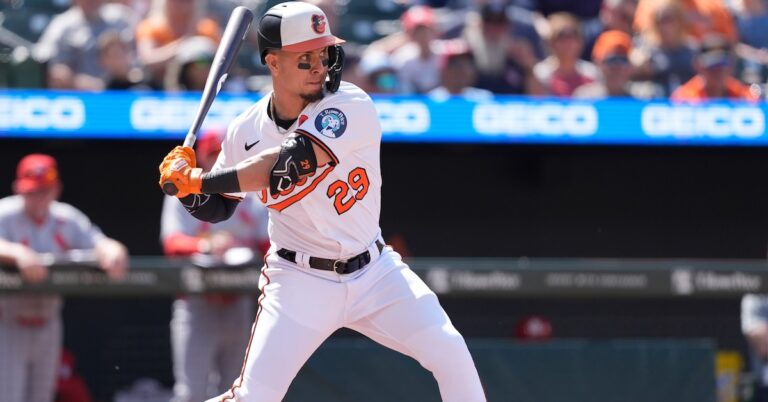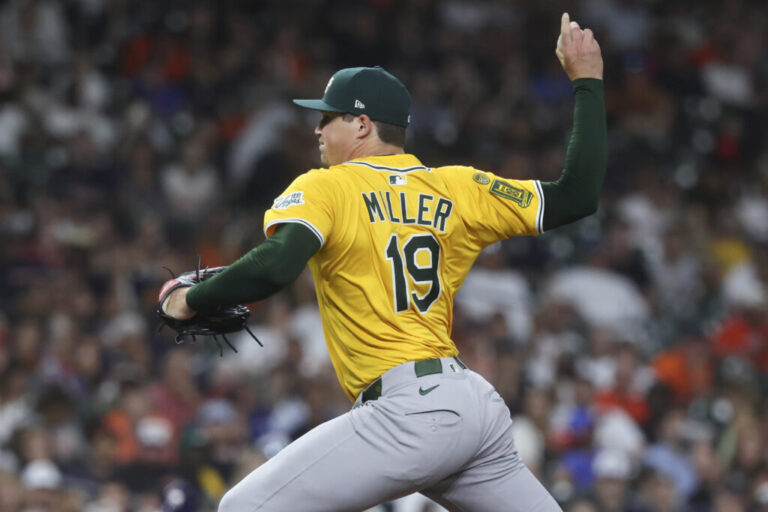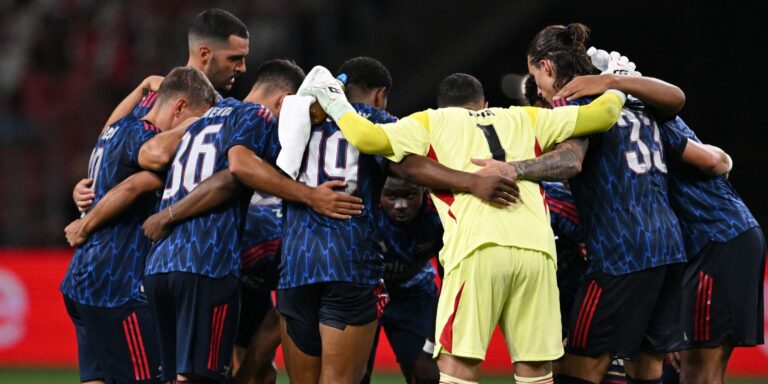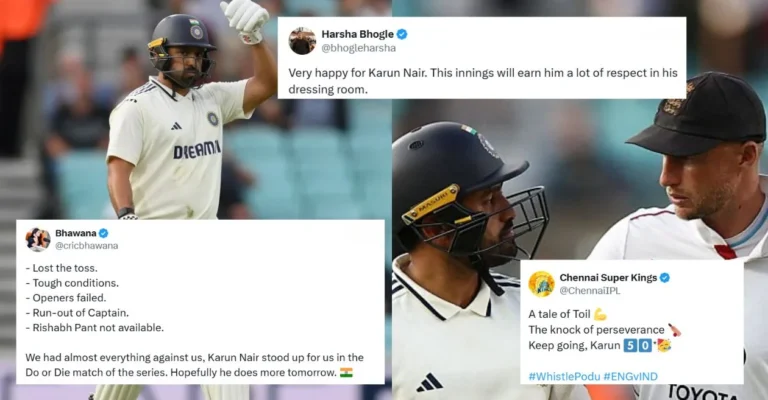
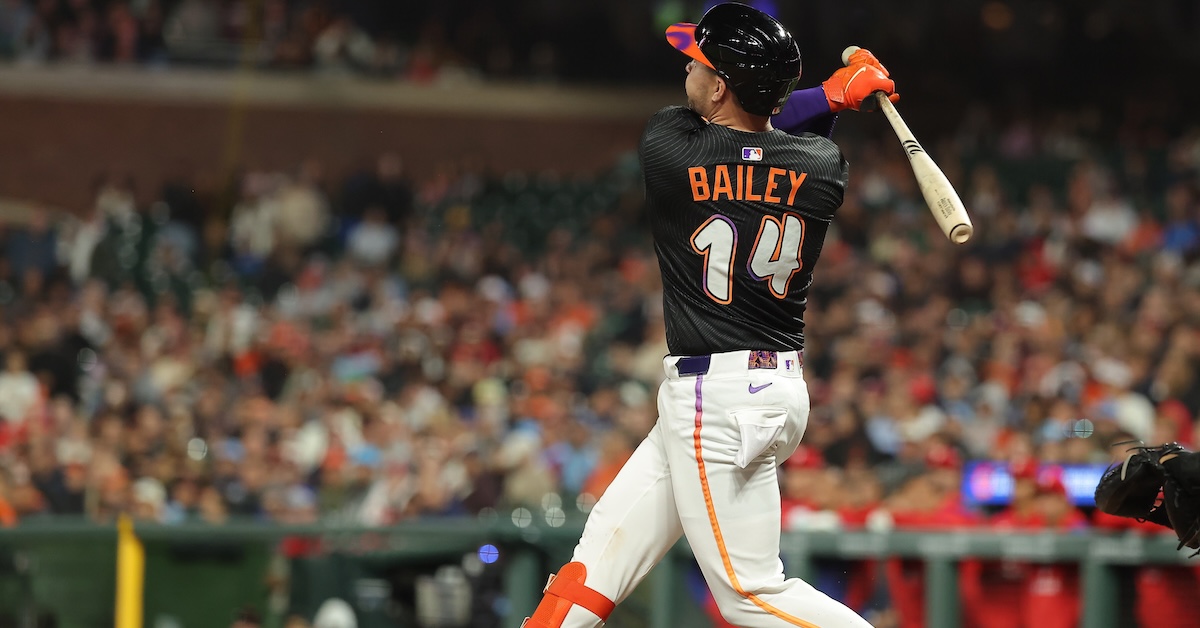
Welcome to another edition of Five Things I Liked (Or Didn’t Like) This Week. Today that title is a bit of a misnomer; I got back from vacation Monday night, so I saw very little baseball before Tuesday. That said, I didn’t need to see very much to have a great time. This week has been awesome. Home runs both mammoth and inside-the-park, great baserunning by slow guys, bad baserunning by slow guys, reflex plays and dekes; the list goes on and on. We might need the All-Star break just to catch our collective breath before a bustling trade deadline and sprint to the finish. For now, though, let’s just marvel at the week – after my customary nod to Zach Lowe of The Ringer, of course.
1. Unconventional Double Plays
Cody Bellinger has been great addition to the Yankees after they acquired him for peanuts over the winter. He is flashing the offensive prowess that has come and gone over the years, and with Trent Grisham manning center, he is playing the corner outfield more than he has in the past. His glove isn’t as good as it was at his peak, but putting a center fielder in left is still a plus for your team defense, as the Mets learned on Sunday. This Juan Soto line drive would have been a hit against almost anyone else:

Statcast gave it a 25% catch probability, and I think it was probably even harder than that. Catch probability measures how far Bellinger had to run and how much time he had to do it, but that ball was absolutely scalded and had so much topspin that it was hooking down hard in the brief time it was in the air. He caught it by the very end of the webbing; “baseball is a game of inches” is usually about the bat hitting the ball or a bang-bang play, but in this case, one inch separated a catch from extra bases:

Oh yeah, then this happened:

That throw is as good of a play as the catch! At full extension, stretched out awkwardly to secure the ball, Bellinger still managed to find first base on the run and unleash an absolute seed that hit Paul Goldschmidt right in the glove on the fly. Making that catch was hard enough. Making it without falling was even harder. Making it without falling and then throwing a frozen rope on target? Almost unthinkable.
Even after that catch, even with that throw, you might wonder why Francisco Lindor got doubled off. Partially, he couldn’t believe anyone could catch that line drive. Partially, too, he got deked. Goldschmidt no-sold the play, barely moving his glove until he absolutely had to. This isn’t the body language of a guy desperate to turn a double play:

That’s not the perfect angle, but you get the idea. The rhythm of this play, to Lindor, didn’t feel like the kind where he’d need to sprint and dive back to first. When someone makes a play that good, you turn around and go back, but what are they going to do, unleash an off-balance missile while the first baseman you’re staring at barely moves? Apparently, yes!
2. Irrational Exuberance
Vladimir Guerrero Jr. is not a good baserunner. That’s not an opinion. He’s been below average in each year of his major league career. He has 24 career steals and has been caught stealing 12 times. He’s slow, and he hits into a lot of double plays. But despite all that, Vlad likes to run. Give him the chance, and he’ll take off. Take Wednesday, for example. Guerrero took advantage of an errant pickoff throw to scamper to second:

You’ve seen that play a million times. Everyone was pretty relaxed about it; in the game audio, you can actually hear Jays first base coach Mark Budzinski calmly telling Vlad “go ahead, go ahead.” But the play wasn’t over:

Yeah, don’t do that. I’ve already mentioned that Guerrero isn’t fleet of foot, but it also took him forever to get moving; acceleration isn’t a strength either. Watch his feet – his first step was actually backwards, out into right field. Adrian Houser was on the wrong side of the mound, but Vlad just didn’t have enough straight line speed to make it matter. To make matters even worse, that was the third out of the inning, at third base, with Addison Barger — one of the teams’ hottest hitters — at the plate. Against the White Sox! Don’t do this.
Don’t do this either:

Now, to be fair, this is a tougher play than before. The underlying cause, though, is similar: a belief that baserunning is easier than it actually is. Elite runners might be safe there. That said, elite runners are a lot faster, and better at sliding, and they’d probably take two steps to their left to better block the throwing lane. That should be an extremely difficult throw for a right-handed first baseman, instead of the easy pitch-and-catch that it was. And once you’re dead to rights, well, hitting the brakes and retreating is a better option than starting your slide so early. You probably won’t survive the rundown, but you might stay in it long enough to give the runner on third time to score before you’re tagged for the final out of the inning.
To Guerrero’s credit, he did try a nifty maneuver at second that nearly rescued the whole thing:

Again, though, leave the high-difficulty baserunning stunts for the high-talent baserunners. Both of these decisions would be excellent if, say, Trea Turner had made them. Knowing what you can accomplish is a key part of accruing value on the bases. Watching what happens when that crucial step doesn’t occur sure is fun for a neutral observer, though.
3. One-up-manship
Kyle Schwarber had himself a game on Tuesday night. He went 2-for-4 with a double and a home run, and that homer was outrageous. Not only did he hit it into McCovey Cove, but he did so more or less flat-footed:

He even showed off another facet of his game an inning earlier, swiping second base off a distracted Robbie Ray:

That brought Schwarber to nine steals on the year, with only one caught stealing. He’s one of the slowest runners in baseball, but he understands the proper application of that speed, generally stealing bases off pitchers who forget about him. He’s not a particularly good baserunner overall, but he’s been picking smart spots to go this year.
One batter later, though, Schwarber tried to double up on his baserunning feat by swiping third. Enter Patrick Bailey:

Schwarber had a great read on Ray; he got an excellent jump in a great spot to steal, with the batter screening the catcher at the plate. Bailey just did everything he had to do that much better:

Watch his footwork there. He cleared batter Alec Bohm and got his lead foot planted at the back of the batter’s box while he was catching the ball. The catch and transfer were both perfect, letting him throw in rhythm. The throw? A laser beam to Matt Chapman’s glove for a tag that got Schwarber by an inch or two. I don’t think Schwarber could have done anything better; he just got beat by perhaps the best defensive catcher in the game.
Bailey is having a miserable season at the plate, but he even outdid Schwarber there, too. The Schwarbomb in the seventh put the Phillies up 3-1, and the score stayed there until Bailey batted with one out in the ninth. Then, well:
It’s hard to imagine a more exciting walk-off than that, and it made for the perfect kicker to this game. Sure, Schwarber had a stolen base and two-run homer, but Bailey had a caught stealing and a walk-off, three-run, inside-the-park homer. Real “anything you can do I can do better” vibes.
4. Two-Way Excellence
Oh, you like inside-the-park home runs? Northern California has your back:

That’s Lawrence Butler leading off the home half of the first for the A’s with an only-in-Sacramento play. It involved the ball kicking off of a chain link fence section of the wall and eluding the entire Braves outfield. That let Butler score even with one of the most nonchalant starts to an inside-the-parker you’ll ever see:
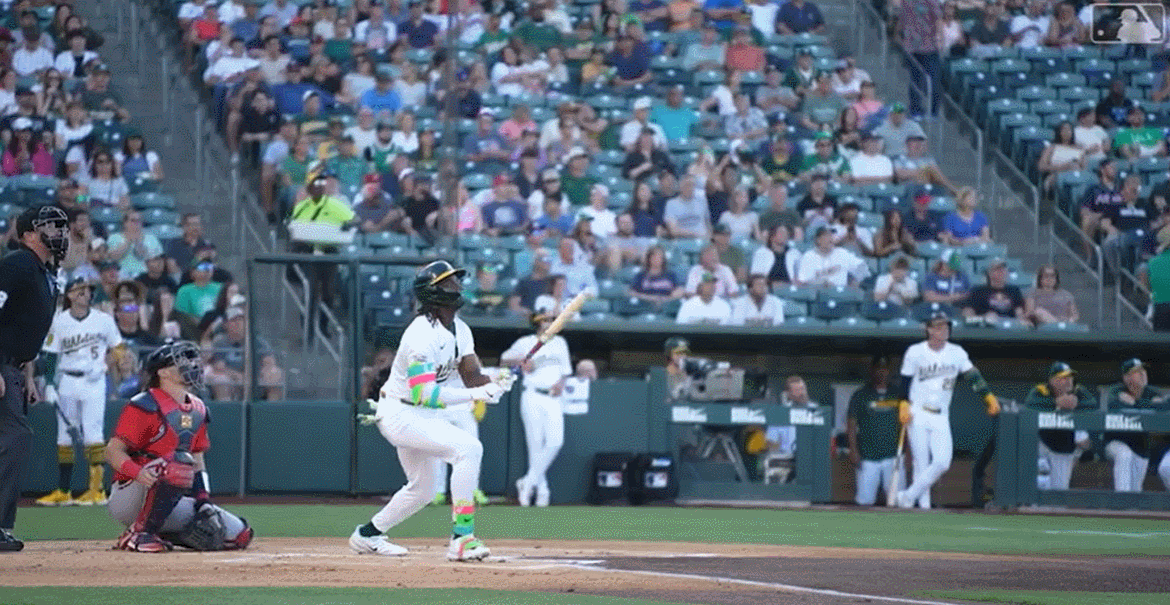
That’s the stride of someone who thought he hit the ball out of the park, but the crazy carom and Butler’s speed made it all work in the end. That’s been a hallmark of his game this year, in fact. He’s not the best defender in the world, but he’s got enough range and instincts to make up for a scattershot arm. He has plenty of swing-and-miss in his game, but he has enough plate discipline to keep his strikeouts from capsizing his offensive contributions. He’s a savvy baserunner capable of hitting top speed faster than you’d think. And he has enough power to make up for any small flaws elsewhere:

Inside the park? Outside the park? Butler has the speed/power combination to accomplish both. He looks like a nice building block of the next good A’s team – not this year’s team, of course, but maybe next year’s. After 1,000 major league plate appearances, it seems pretty clear that he’s a solid all-around player but not quite a star. That’s just fine for both the contract and the prospect pedigree, though – and as a huge bonus, he’s tremendously fun to watch. More home runs like these, please.
5. Raw Power
More home runs like these, too. Jac Caglianone was playing college baseball last year. The sixth pick in the 2024 draft, he looked more like a developmental stash than a plug-and-play star. He played both ways in college, though he was clearly a lot better offensively, and the Royals drafted him with that in mind. But he was raw, with iffy command of the strike zone and a swing-first mentality that led to ugly swings over sliders.
A whirlwind tour of the minors – 158 wRC+ in Double-A, 164 in Triple-A – convinced Kansas City to call him up at the beginning of June. Through just over a month of play, the results have been disappointing; Caglianone is hitting .151/.205/.286, for a 31 wRC+. But the results are lying. He’s been much better than I thought he’d be, to be quite honest. He’s running a 22% strikeout rate, far lower than I would have expected given that he’s chasing 41% of the pitches he sees outside the strike zone, one of the worst marks in the big leagues. The stats might be rough, but the process isn’t; by xwOBA, he’s been about an average hitter, rather than 70% below average, thanks to his prodigious exit velocities.
In other words, over the long run. Caglianone is going to hit for a lot of power. He’s already hitting the ball very hard, in fact, he just hasn’t quite harnessed that into doubles and dingers. But oh my god, have you seen what it looks like when he gets hot? Tuesday night, he did this:

If you want to know how scalded that ball was, watch the outfielders. Those are courtesy jogs, not “maybe I can get this one” sprints. That was 114 mph off the bat, the kind of home run that only the Judges and Stantons of the world can consistently pull off. When you hit the ball that low (19 degrees), it’s hard to leave the stadium. Caglianone is part of that group of elite power hitters already.
One hard-hit ball often begets another. His results so far have been poor, but he’s clearly close to unlocking something. If you leave a pitch over the middle of the plate against Caglianone, it’s going to travel a long way. Look at this nonsense from the next day:

That’s not a reasonable place to hit a home run. It went 466 feet, some real Bo Jackson stuff. I had the volume cranked up on this game, and the crack of the bat was so thunderous that the entire crowd went “ooooh” in unison. He might not have hit that ball quite as hard as the previous one, but he got it at the perfect angle and still tattooed it. His power binges are park-proof; Kaufmann Stadium is the stingiest stadium in baseball for left-handed power hitters, but if you hit the ball as hard as Caglianone does, it doesn’t matter where the fence is.
I didn’t think Caglianone was going to hit the majors this quickly. I’m still kind of surprised at how well he’s adapted to big league pitching; he’s getting attacked relentlessly on the inside part of the plate and chasing 40% of the time, and yet still running reasonable strikeout rates. But I’m not at all surprised at how fun he is to watch – and I can’t wait for more rainmaking home runs, and more mob movie celebrations in the dugout:

